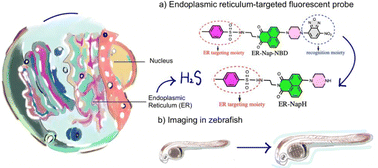Observing hydrogen sulfide in the endoplasmic reticulum of cancer cells and zebrafish by using an activity-based fluorescent probe†
Abstract
A crucial endogenous signaling chemical, hydrogen sulfide, is involved in many physiological actions. In this work, we created the fluorescent probe ER-Nap-NBD using a naphthalimide fluorophore as the signal reporter, a 7-nitro-1,2,3-benzoxadiazole amine as the responsive moiety, and a sulfonamide part for endoplasmic reticulum targeting. ER-Nap-NBD could be detected the H2S levels in solution and in living systems (cells and zebrafish).

- This article is part of the themed collections: ChemComm Most Popular 2023 Articles and Chemosensors and Molecular Logic


 Please wait while we load your content...
Please wait while we load your content...